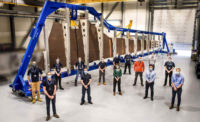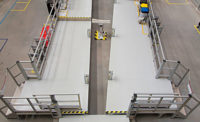Testing programs have been in place there since 2002. The programs were developed in conjunction with MK Test Systems, a UK-based manufacturer of high-voltage equipment, and MK’s
regional distributor, Tyco Electronics.
Test systems are used at each stage of wing production for both full-size and single-aisle aircraft. Function testing the electrical systems of wing assemblies for single-aisle aircraft has been particularly beneficial for Airbus.
Function testing involves a systems test unit (STU) and final functional test unit (FFTU). The STU tests the fuel level sensing system and the fuel quantity indicator system, which includes probe capacitance, candensicon capacitance and voltage, all lighting and various electric fuel and hydraulic valves.
Before STU, Airbus used a range of semiautomatic systems that required two operators. Also, test reports had to be printed out, and they required extensive manual documentation of results.
STU eliminates the paper test reports and integrates automatic program generation into the testing process. Most importantly, STU saves up to two hours of labor per wing set by enabling single-operator operation via a handheld remote control module.
The benefits of STU prompted Airbus to purchase FFTU, which is used to test the functional performance of the flight control surfaces and actuators. The company then integrated both test units into the production lines at Broughton and Tianjin.
Functional performance testing is a four-step process. First, FFTU automatically generates a test program based on the wing variant. Second, FFTU automatically drives the flaps, slats, ailerons, and spoilers through the range of motion while simultaneously receiving angle of inclination feedback from an integral inclinometer module.
Next, FFTU checks this angle against the feedback from the wing linear variable displacement transducers and asymmetry position pick off unit to ensure correct function and that the correct angle is achieved for each range of signal delivered to the actuator units.
Finally, FFTU automatically enables final rigging, setting and testing of the flight control surfaces and actuators prior to the wings being connected to the aircraft fuselage.
Before FFTU, Airbus had to perform several individual test units that involved numerous operators and a high degree of manual documentation of results.
Because STU and FFTU are integrated with measurement modules, Airbus can perform specific tests as desired. Data generated by STU and FFTU is automatically transmitted through a wireless network, and test results are automatically uploaded into SQL for analysis and final delivery to SAP.
“The STU and FFTU projects have proven a success,” says Simon Dolman, engineering group leader at Airbus. “The STU now meets the ASTG (NASA aerospace test group) specification at 100 percent. Benefits achieved with the new STU have been assessed and confirmed by the industrial engineers.”
For more information on electrical test systems, call 717-564-0100 or visit www.tycoelectronics.com.



